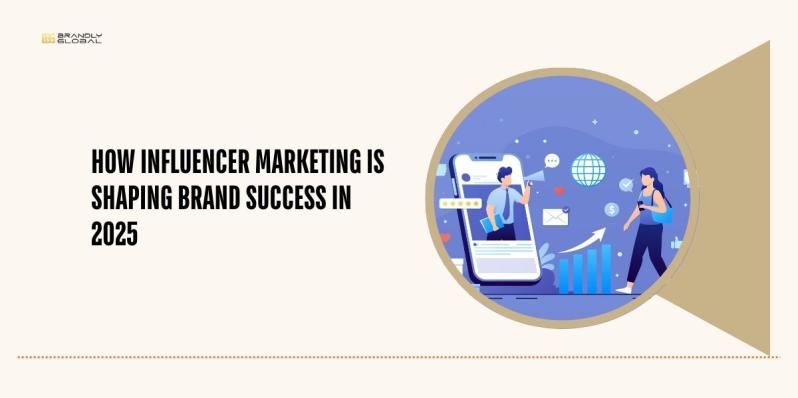How Influencer Marketing is Shaping Brand Success in 2025
- admin's Blog
- Log in or register to post comments

In the fast-paced digital era, influencer marketing has moved beyond being a passing trend—it’s now a key driver of brand growth. As we enter 2025, the industry has transformed in significant ways. Consumers no longer respond to traditional ads the way they used to. Instead, they trust the voices of real people—creators, micro-influencers, and niche leaders who shape opinions every day on social media.
In this article, we’ll explore how influencer marketing is shaping brand success in 2025, the trends driving it forward, and how businesses can adapt to stay ahead.
Why Influencer Marketing Matters in 2025
Influencer marketing has become essential for brands to stay relevant. Why? Because it delivers three things that traditional marketing often can’t: authenticity, trust, and direct audience connection.
Key reasons why it's booming in 2025:
- Creator-led commerce is replacing conventional advertising.
- Consumers seek relatable content, not polished ads.
- Brands are tapping into niche communities for higher engagement.
The Role of Micro and Nano Influencers
While mega-influencers still have their place, 2025 is truly the year of the micro (10K–100K followers) and nano influencers (under 10K followers). These creators offer higher engagement and more loyal followings, making them ideal partners for targeted campaigns. You can check here for details on Top Jewellery Influencers in India - Brandly Global.
Benefits of working with micro/nano influencers:
- Authentic storytelling
- Niche audience reach
- Better ROI due to lower cost and higher engagement
Emerging Trends in Influencer Marketing (2025)
Influencer marketing has matured. Brands are no longer focused on follower counts—they care about results. Here are the hottest trends defining 2025:
- AI-powered influencer discovery tools for better matchmaking
- Performance-based collaborations, where creators are paid for results
- Cross-channel content including Instagram Reels, Threads, and YouTube Shorts.
- Affiliate-integrated influencer campaigns for revenue tracking
Brand Success Stories Driven by Influencers
Here are just a few ways influencer partnerships have fueled real brand growth:
📌 Case Study: Sustainable Fashion Brand
A collaboration with 30 micro-influencers resulted in a 62% boost in engagement and a 28% increase in sales within a single campaign cycle.
📌 Case Study: Skincare Startup
Partnered with nano influencers across wellness YouTube channels, resulting in 5X product trials in the first 30 days.
Metrics That Matter in 2025
Brands are no longer guessing success—they’re measuring it.
Key influencer marketing metrics:
- Engagement Rate (ER) – likes, shares, comments per post
- Conversion Rate – clicks that lead to action (sales, sign-ups)
- Cost per Engagement (CPE) – how much each interaction costs
- Customer Lifetime Value (CLTV) – how valuable an acquired customer becomes over time
Challenges and How to Overcome Them
Every strategy has its obstacles, and influencer marketing is no exception. But the right planning can prevent most issues.
Common challenges:
- Fake followers and inflated engagement
- Increased costs for top-tier influencers
- Algorithm changes across platforms
Solutions:
- Use platforms like Brandly Global to vet influencers
- Rely on data-driven insights over vanity metrics
- Build long-term partnerships, not one-off deals
✅ Collaborate with trusted influencers through Brandly Global.
How to Find the Best Influencer Match for Your Brand
Choosing the right influencer can determine the success or failure of your campaign.
Things to consider:
- Audience fit – Are their followers your target customers?
- Engagement – Are people commenting, clicking, and caring?
- Content style – Is it consistent with your brand’s tone and messaging?
The Future of Influencer Marketing Beyond 2025
As we look ahead, influencer marketing will continue to evolve into something even more dynamic.
What’s coming next:
- Virtual influencers and avatars are gaining popularity
- Creator-owned brands and subscription content becoming mainstream
- Metaverse integrations for immersive brand experiences
- Full brand-creator collaborations on product development and marketing
Conclusion
Influencer marketing in 2025 is a powerful, data-driven tool that goes beyond simple social media shoutouts. It's all about genuine people, authentic conversations, and measurable business outcomes.
To succeed in today’s market, brands must:
- Align with authentic creators
- Measure what matters
- Embrace emerging platforms and tech
Whether you’re new to influencer campaigns or looking to optimize your strategy, now is the time to act.
Frequently Asked Questions (FAQs)
❓ What is influencer marketing in 2025?
Answer:
Influencer marketing in 2025 involves partnering with online content creators to promote brands authentically across social platforms. With advanced analytics, AI-powered tools, and performance-based collaborations, brands now prioritize measurable results over follower counts.
❓ How does influencer marketing help brands succeed?
Answer:
Influencer marketing helps brands by building trust, reaching niche audiences, and driving high engagement. In 2025, it will play a critical role in brand visibility, customer acquisition, and direct sales through relatable and creator-led content.
❓ How do brands measure influencer marketing success?
Answer:
Brands measure success through metrics like engagement rate, conversion rate, cost per engagement (CPE), and customer lifetime value (CLTV). Tools and platforms like Brandly Global provide detailed performance analytics.
❓ How do I choose the ideal influencer for my brand?
Answer:
Choose influencers who reflect your brand’s values, engage actively with their audience, and consistently create high-quality content. Platforms like Brandly Global help brands connect with verified and relevant influencers.
❓ What are the biggest challenges in influencer marketing?
Answer:
Common challenges include fake followers, rising costs, and platform algorithm changes. Overcoming these requires data-backed influencer vetting, long-term partnerships, and using trusted influencer marketing platforms.
❓ Is influencer marketing cost-effective for small businesses?
Answer:
Yes. Small businesses benefit from working with nano and micro influencers who offer strong engagement at a lower cost. These partnerships can be tailored to budgets and deliver significant brand awareness and conversions.
